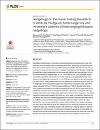Hedgehogs on the move: Testing the effects of land use change on home range size and movement patterns of free-ranging Ethiopian hedgehogs

View/
Date
2017Author
Abu Baker, Mohammad A.Reeve, Nigel
Conkey, April A. T.
Macdonald, David W.
Yamaguchi, Nobuyuki
Metadata
Show full item recordAbstract
Degradation and alteration of natural environments because of agriculture and other land uses have major consequences on vertebrate populations, particularly on spatial organization and movement patterns. We used GPS tracking to study the effect of land use and sex on the home range size and movement of a typical model species, the Ethiopian hedgehogs. We used free-ranging hedgehogs from two areas with different land use practices: 24 from an area dominated by irrigated farms (12 ♂♂, 12 ♀♀) and 22 from a natural desert environment within a biosphere reserve (12 ♂♂, 10 ♀♀). Animals were significantly heavier in the resource-rich irrigated farms area (417.71 ±12.77SE g) in comparison to the natural desert area (376.37±12.71SE g). Both habitat and sex significantly influenced the home range size of hedgehogs. Home ranges were larger in the reserve than in the farms area. Total home ranges averaged 103 ha (±17 SE) for males and 42 ha (±11SE) for females in the farms area, but were much larger in the reserve averaging 230 ha (±33 SE) for males and 150 ha (±29 SE) for females. The home ranges of individuals of both sexes overlapped. Although females were heavier than males, body weight had no effect on home range size. The results suggest that resources provided in the farms (e.g. food, water, and shelters) influenced animal density and space use. Females aggregated around high-resource areas (either farms or rawdhats), whereas males roamed over greater distances, likely in search of mating opportunities to maximize reproductive success. Most individual home ranges overlapped with many other individuals of either sex, suggesting a non-territorial, promiscuous mating. Patterns of space use and habitat utilization are key factors in shaping aspects of reproductive biology and mating system. To minimize the impacts of agriculture on local wildlife, we recommend that biodiversity-friendly agro-environmental schemes be introduced in the Middle East where the transformation from dry lands to ‘islands of fertility’ is often extreme.
Collections
- Biological & Environmental Sciences [933 items ]

